

Been there before? Baphomet. "Bahomet" redirects here.

It is not to be confused with Bahamut. The 19th century image of a Sabbatic Goat, created by Eliphas Levi. The arms bear the Latin words SOLVE (separate) and COAGULA (join together), i.e., the power of "binding and loosing" usurped from God and, according to Catholic tradition, from the ecclesiastical hierarchy acting as God's representative on Earth.
Multiverse. Palmistry. Palmistry, or chiromancy (also spelled cheiromancy; from Greek kheir (χεῖρ, ός; “hand”) and manteia (μαντεία, ας; “divination”)), is the claim of characterization and foretelling the future through the study of the palm, also known as palm reading or chirology.

The practice is found all over the world, with numerous cultural variations. Those who practice chiromancy are generally called palmists, palm readers, hand readers, hand analysts, or chirologists. The information outlined below is briefly representative of modern palmistry; there are many ― often conflicting ― interpretations of various lines and palmar features across various schools of palmistry. These contradictions between different interpretations, as well as the lack of empirical support for palmistry's predictions, contribute to palmistry's perception as a pseudoscience among academics.
History[edit] Satanism. The downward-pointing pentagram is often used to represent Satanism.
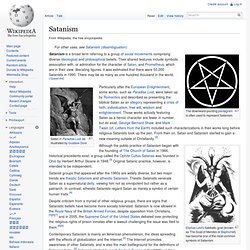
Satanism is a broad term referring to a group of social movements comprising diverse ideological and philosophical beliefs. Their shared features include symbolic association with, or admiration for the character of Satan, and Prometheus, which are in their view, liberating figures. It was estimated that there were 50,000 Satanists in 1990. There may be as many as one hundred thousand in the world.[1][dead link] Theistic Satanism. The history of theistic Satanism, and assessments of its existence and prevalence in history, is obscured by it having been grounds for execution at some times in the past, and due to people having been accused of it who did not consider themselves to worship Satan, such as in the witch trials in Early Modern Europe.
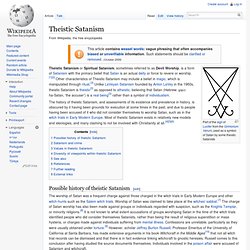
Most of theistic Satanism exists in relatively new models and ideologies, and many claiming to not be involved with Christianity at all.[4][5][6] Septenary (Theosophy) The Septenary in Helena Blavatsky's teachings refers to the seven principles of man.
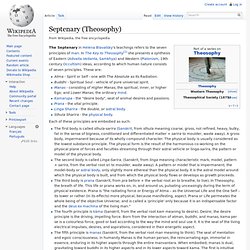
In The Key to Theosophy[1] she presents a synthesis of Eastern (Advaita Vedanta, Samkhya) and Western (Platonism, 19th century Occultism) ideas, according to which human nature consists of seven principles. These are: Each of these principles are embodied as such: List of New Age topics. Transcendental Meditation technique. The Transcendental Meditation technique is a specific form of mantra meditation[1] developed by Maharishi Mahesh Yogi. It is often referred to as Transcendental Meditation, or simply TM. The meditation practice involves the use of a mantra and is practiced for 15–20 minutes twice per day while sitting with one's eyes closed.[2][3] It is reported to be one of the most-widely practiced,[4][5][6] and among the most widely researched meditation techniques,[7] with over 340 peer-reviewed studies published.[8][9] Beginning in 1965, the Transcendental Meditation technique has been incorporated into selected schools, universities, corporations, and prison programs in the U.S.A., Latin America, Europe, and India.
Magick. Shamanism. The earliest known depiction of a Siberian shaman, produced by the Dutch explorer Nicolaes Witsen, who authored an account of his travels among Samoyedic- and Tungusic-speaking peoples in 1692.
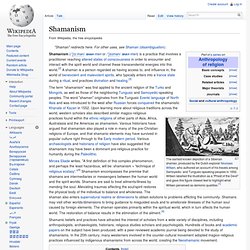
Witsen labelled the illustration as a "Priest of the Devil" and gave this figure clawed feet to highlight what Witsen perceived as demonic qualities.[1] Shamanism (/ˈʃɑːmən/ SHAH-mən or /ˈʃeɪmən/ SHAY-mən) is a practice that involves a practitioner reaching altered states of consciousness in order to encounter and interact with the spirit world and channel these transcendental energies into this world.[2] A shaman is a person regarded as having access to, and influence in, the world of benevolent and malevolent spirits, who typically enters into a trance state during a ritual, and practices divination and healing.[3] Occult. Astrology. Spirit guide. "Spirit guide" is a term used by the Western tradition of Spiritualist Churches, mediums, and psychics to describe an entity that remains a disincarnate spirit in order to act as a guide or protector to a living incarnated human being.

Traditionally, within the spiritualist churches, spirit guides were often stereotyped ethnically, with Native Americans, Chinese or Egyptians being popular for their perceived ancient wisdom. Other popular types of guides were saints or other enlightened individuals. Nevertheless, the term can also refer to totems, angels, guardian angels or nature spirits. Description[edit] According to theosophical doctrine, spirit guides are not always of human descent.
Some early modern Spiritualists did not favor the idea of spirit guides. Firsthand Accounts[edit] Five Tibetan Rites. The Eye of Revelation by Peter Kelder The Five Tibetan Rites is a system of exercises reported to be more than 2,500 years old[1] which were first publicized by Peter Kelder in a 1939 publication titled The Eye of Revelation.[2] The Rites are said to be a form of Tibetan yoga similar to the yoga series that originated in India.
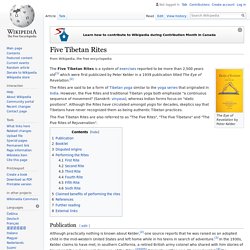
However, the Five Rites and traditional Tibetan yoga both emphasize "a continuous sequence of movement" (Sanskrit: vinyasa), whereas Indian forms focus on "static positions". Ananda yoga. Ananda Yoga, or Ananda Yoga for Higher Awareness[1] is a system of Hatha Yoga established by Kriyananda, a disciple of Paramahansa Yogananda, and is based on his Kriya Yoga teachings.

Ananda Yoga emphasizes inner awareness; energy control; and the experience of each asana as a natural expression of a higher state of consciousness, which is enhanced by the use of affirmations. History[edit] Ananda Yoga was established from one of the oldest Hatha Yoga systems in the West. Its roots are the 1940/1950ies, when Kriyananda was asked by Yogananda, founder of Self-Realization Fellowship (SRF), to demonstrate the postures for visiting guests, as well as for public events, such as the SRF "Lake Shrine Dedication. " Kriyananda also modeled for photos, for articles on the yoga postures in Yogananda's "Self-Realization Magazine. Black magic.
History[edit] Like its counterpart white magic, the origins of black magic can be traced to the primitive, ritualistic worship of spirits as outlined in Robert M.

Place's 2009 book, Magic and Alchemy.[3] Unlike white magic, in which Place sees parallels with primitive shamanistic efforts to achieve closeness with spiritual beings, the rituals that developed into modern "black magic" were designed to invoke those same spirits to produce beneficial outcomes for the practitioner. Place also provides a broad modern definition of both black and white magic, preferring instead to refer to them as "high magic" (white) and "low magic" (black) based primarily on intentions of the practitioner employing them.
Time slip. Cases[edit] Ghosts of Versailles[edit] One of the best-known, and earliest, examples of a time slip was reported by two English women, Charlotte Anne Moberly (16 September 1846 - 7 May 1937) and Eleanor Jourdain (1863–1924), the principal and vice-principal of St Hugh's College, Oxford, who claimed they slipped back in time in the gardens of the Petit Trianon at Versailles from the summer of 1901 to the period of the French Revolution. The Vanishing Hotel[edit] Necromancy. The word "necromancy" is adapted from Late Latin necromantia, itself borrowed from post-Classical Greek νεκρομαντεία (nekromanteía), a compound of Ancient Greek νεκρός (nekrós), "dead body", and μαντεία (manteía), "prophecy or divination"; this compound form was first used by Origen of Alexandria in the 3rd century CE.[3] The Classical Greek term was ἡ νέκυια (nekyia), from the episode of the Odyssey in which Odysseus visits the realm of the dead, νεκυομαντεία in Hellenistic Greek, rendered as necyomantīa in Latin, and as necyomancy in 17th-century English.[4] Antiquity[edit] Early necromancy was related to – and most likely evolved from – shamanism, which calls upon spirits such as the ghosts of ancestors.
Pagan and wiccan. Religion. Lucid dream. A lucid dream is any dream in which one is aware that one is dreaming. In relation to this phenomenon, Greek philosopher Aristotle observed: "often when one is asleep, there is something in consciousness which declares that what then presents itself is but a dream".[1] One of the earliest references to personal experiences with lucid dreaming was by Marie-Jean-Léon, Marquis d'Hervey de Saint Denys.[2] Skeptics of the phenomenon suggest that it is not a state of sleep, but of brief wakefulness.[15][16] Others point out that there is no way to prove the truth of lucid dreaming other than to ask the dreamer.[17] Lucid dreaming has been researched scientifically, with participants performing pre-determined physical responses while experiencing a lucid dream.[18][19] Scientific history[edit] Philosopher Norman Malcolm's 1959 text Dreaming[22] had argued against the possibility of checking the accuracy of dream reports.
Hearne's results were not widely distributed. Aura (paranormal) The Human Aura in a healthy woman after a diagram by Walter John Kilner (1847-1920). The picture depicts Kilner's "inner and outer auras. " Colours have been added for illustrative purposes and have no other significance. An old Iranian Shi'a Muslim impression of Jesus and Mary shows an aura after the style of the farr. The Lesser Key of Solomon. Masters of the Ancient Wisdom (Theosophy) Christian crap. Medieval runes. Ouija. Mindstream. Kabbalah. Chakra. From an 1899 Yoga manuscript in the Braj Bhasa language. Spiritualism. The World's Sixteen Crucified Saviors. The World's Sixteen Crucified Saviors (1875) The World's Sixteen Crucified Saviors (or Christianity Before Christ) is an 1875 book written by Kersey Graves. It asserts that Jesus was not an actual person, but was a creation largely based on earlier stories of deities or god-men saviours who had been crucified, and descended to and ascended from the underworld.
Parts were the reprinted in The Book Your Church Doesn't Want You to Read edited by Tim C. List of occult terms. LGBT topics and Wicca. Astral projection. Out-of-body experience. Second sight.